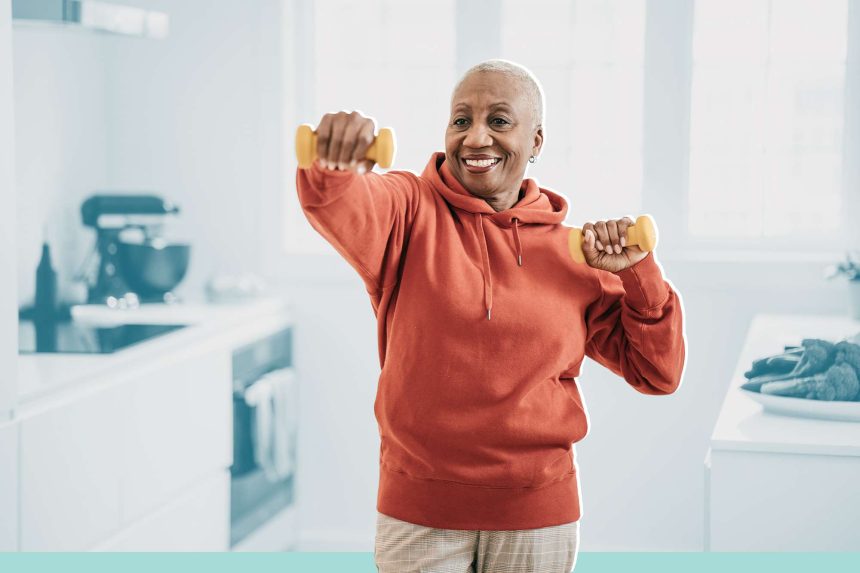No matter your age, exercise is the foundation for a healthy brain and body. When you’re over 50 “the focus of exercise is on longevity,” says Damien Joyner, JD, ACE-Certified personal trainer and founder of Incremental Fitness in San Diego, CA. Longevity doesn’t just mean living longer, but living longer with a quality of life you want and enjoy, he says. And some of the best exercises for women over 50 are things you can start doing today.
The focus for women over 50 is to reduce risks of conditions that are a threat to your well-being, such as low bone density, falls and heart disease, says Joyner. “A regular exercise routine that is well-rounded will improve and maintain muscular strength, cardiovascular health, agility, coordination, brain health, posture and flexibility,” he adds.
So, what exercises will deliver those benefits—and more? “The best type of workouts for people over 50 are the ones that meet them at their current fitness level and challenge them enough to maintain or improve how they move and feel,” says Joyner.
Try one or two of these exercises each day to feel stronger and healthier, inside and out.
1. A Fast-Paced Walk for General Health
Walking is frequently recommended as one of the best ways to workout. Not only do studies show that hoofing it after meals can lower your blood sugar response to that meal, it’s an easy activity to make enjoyable by walking with a friend, listening to a podcast or enjoying the sights and sounds of nature.
One snag: “Often people tell me that walking isn’t as effective as it used to be or they’re bored with it,” says Joyner. He suggests boosting the intensity of your walk so that you are moving at a quick pace—like you’re walking with purpose versus a leisurely stroll. You can increase intensity by planning to walk a route with a couple of hills, which will more effectively challenge your heart, lungs and muscles, he suggests.
2. Weight Bearing Exercises to Strengthen Bones
After about age 30, bone mass starts to decline. Weight-bearing exercises help to preserve skeletal muscle by loading, or stressing, bones, ultimately stimulating bone-forming cells. This type of exercise is instrumental in helping women maintain bone mineral density. Any type of weight bearing activity that provides some impact will buoy bone health, too. “Hiking outside, playing sports like tennis, or dancing can be great ways to get ‘extra credit’ to maintain bone mass,” Joyner says. Resistance exercises—think lifting weights—can also help your bones.
3. Pool Workouts If You Have Joint Aches and Pains
If exercise is uncomfortable, you may be reluctant to do it, but it’s still important to find ways to stay active. Joyner recommends moving in the water. “Aqua classes are a great way to increase strength and cardiovascular health,” he says. Water provides a low-impact setting for movements and warmer water increases joint mobility, Joyner adds. What’s more, these workouts may make everyday movements feel better. “As the saying goes, ‘motion is lotion.’ With patience and sometimes working with an experienced professional, you can come to appreciate and enjoy how exercise can help reduce your pain,” he says. A pair of sporty goggles or aqua fitness barbells can make your water workouts more fun and efficient.
4. Biking to Boost Your Brain
The combination of being outdoors and physical movement is tops for your cognitive capabilities. In older adults, biking for simply 20 minutes may improve the functioning of the hippocampus—the part of the brain responsible for memory, learning and problem solving.
If traditional biking isn’t your thing, try an e-bike. E-bikes are skyrocketing in popularity for a reason: They allow you to enjoy commuting, running errands, traveling longer distances or biking with less effort, but still keep you outside and active.
5. Resistance Exercise to Maintain Muscle
Sarcopenia is muscle loss and weakness that occurs in some elderly people. Now is the time to exercise in a way that will maintain the muscle mass that is crucial in keeping you mobile and functional well into your later years and avoid devastating falls. How? Pick up weights. Doing so challenges and strengthens muscles, and resistance training is the most effective way to counter this condition.
When Joyner coaches clients, he recommends focusing on functional movements, which mimic the way your body moves every day. For example, a resistance exercise to support your ability to pick things up is a deadlift. Doing push-ups (or modified push-ups, based on your ability) will help you with your ability to “push” in real life. And practicing squats is instrumental in rising from a seated position, something you do multiple times throughout the day, he says.
6. Yoga to Improve Balance and Flexibility
You don’t have to be able to bend over and touch your toes to enjoy yoga. Research shows that mind-body practice improves physical balance and lower body flexibility and strength, as well as mental health. In other words: Yoga makes you feel better all around. Yoga is low impact, meaning it is a safe and effective practice to continue as you age. How’s that for a feel-good workout?
The Bottom Line
Exercise after 50 may look similar to what you did when you were younger with a few modifications. Maintaining a strong and healthy body means working with functional exercises that promote everyday movement and the ability to perform tasks without strain, falls or injury. Try one of these six exercises to promote a healthy heart, strong muscles and bones, an active brain, and better balance and flexibility.






